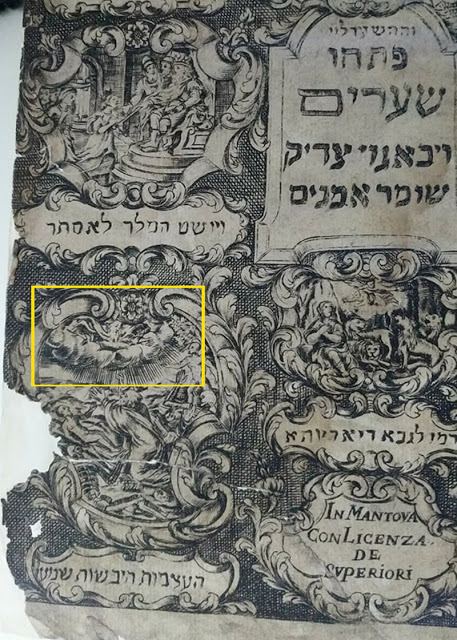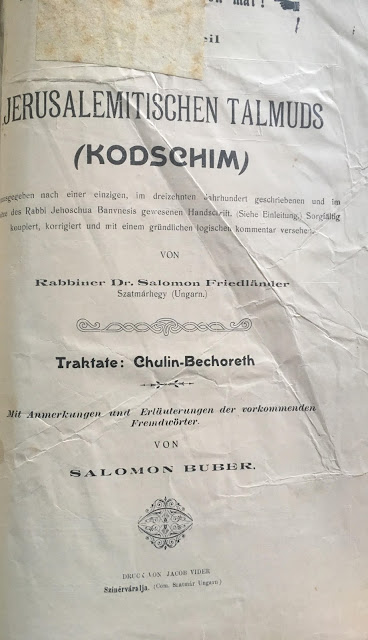New Auction House – Genazym
by Dan Rabinowitz, Eliezer Brodt
There is a new auction house, Genazym, that is holding
its inaugural auction next week Monday, December 25th. The
catalog is available here. The majority of the material are letters
and other ephemera with a few dozen books. The books include a number with
vellum bindings (71-75). Appreciation of bindings has been brought to
fore with the recent wider availability of books from the Valmadonna collection
after it was broken up; a collection that was known for its exquisite bindings.[1]
images. The title-page of the first edition of R. Yedidia Shlomo of
Norzi’s commentary on the biblical mesorah, Minhat Shai, Mantua,
1742-44 (76), includes Moses with horns, but more offensive is the depiction
of God with a human face. The images on the title page are various
biblical vignettes and in the one for the resurrection of the “dry
bones” that appears in Yehkezkel, God is shown as an old man with a white
beard. [2] Another title-page containing non-Jewish imagery is the Smikhat
Hakhamim, Frankfurt, 1704-06 (87). Its title page is replete with
mythological (?) or Christian (?) imagery. [3]
The illustration on the Minchat Shai title page. Note that this is from another copy, not the one on auction.
The kabbalistic work, Raziel haMalach, (77) contains
illustrations of various amulets with various mythical
creatures. [4] Another book with mystical images is the Emek Halakha,
Cracow 1598, (80). Less sensational images, of ships and fauna,
appear in the first Hebrew book to describe America, Iggeret Orkhot
Olam, Prague 1793, (83). [5] R. Tovia ha-Rofeh’s Ma’ase Tovia,
Venice, 1707, (95) contains an elaborate illustration that compares the human
organs with various parts of a house or building. [6]
Of note for its rarity is (88), a first printing of R’ Moshe Chaim Luzzatto’s Derech Tevunot, Amsterdam 1742. The copy is a miniature, and was owned by the great collector Elkan Nathan Adler.
most controversial books in the history of Jewish literatures the forged Yerushalmi on Kodshim, (likely) written by
Shlomo Yehudah Friedlander (98). There are two versions of the book, one
printed on thick paper and, on a second title page, Friedlander is referred to as
a doctor. The other version is printed on poor paper and lacks the
(presumably bogus) academic credential. The theory behind
the variants is that one was targeted at academic institutions
and the other at traditional Jews. [7] Here is what it looked like:
Here are highlights from some of the letters for sale:
printer. Norzi referred to the work as Goder Peretz. See
Jordan Penkower, “The First Printed Edition of Nozri’s Introduction to Minhat
Shai, Pisa 1819,” Quntres 1:1 (Winter 2009), 9
n2. The introduction to Minhat Shai was printed
long after the work itself. See Penkower, idem. Moses crowned with horns appears in the earliest
depiction of him to adorn a Hebrew book’s title page. See “Aaron the
Jewish Bishop,” here.
the first edition of the Teshuvot ha-Bah and Beit
Ahron. Regarding the usage of these title-pages, see Dan
Rabinowitz, “The Two Versions of the Bach’s Responsa, Frankfurt Edition of
1697,” Alei Sefer 21 (2010) 99-111.
and Ritual Object: A Historical and Bibliographical Study in Sefer Razi’el
ha-Malakh and its Editions,” (Ramat Gan: MA Thesis, Bar-Ilan
University, 2014). Regarding the prevalence of mythical creatures in
human society see Kathryn Schulz, “Fantastic Beasts and How to Rank
Them,” New Yorker, Nov. 6, 2017 (here).
Renaissance Jew: The Life and Thought of Abraham ben Mordecai
Farissol (Cincinati: Hebrew Union College, 1981).
was recently analyzed by Etienne Lepicard, “An Alternative to the Cosmic and
Mechanic Metaphors for the Human Body? The House Illustration in Ma’ashe
Tuviyah (1708),” Medical History 52 (2008), 93-105.
Friedlander’s edition, see Eliezer Brodt, “Tziyunim u-Meluim le’Mador ‘Netiah
Soferim’” Yeshurun 24 (2011) 454-455.




